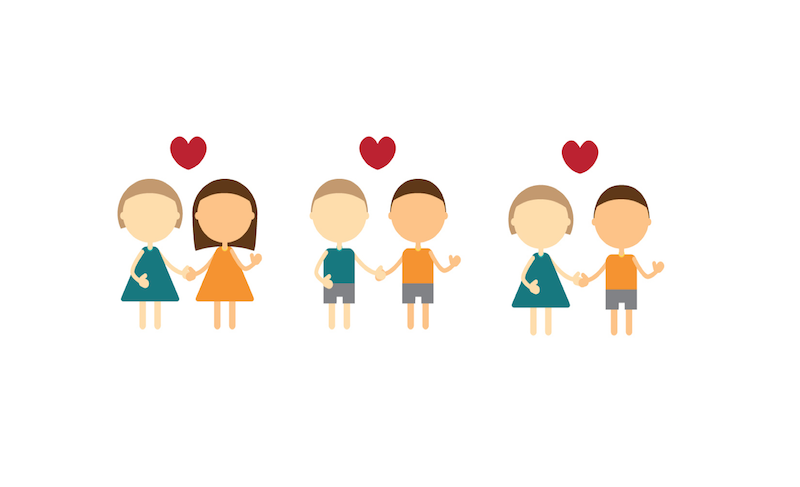
More and more young men and women in the U.S. report having some attraction to members of the same sex, according to new national survey data.
In particular, more men now say they are "mostly attracted to the opposite sex," rather than "only" attracted to the opposite sex compared to previous years, according to the survey from researchers at the Centers for Disease Control and Prevention.
The new trend may result from greater societal acceptance of same-sex relationships, said Ritch Savin-Williams, a professor of developmental psychology at Cornell University who researches sexual orientation and behavior.
This change, however, probably doesn't mean that more men now than in the past are feeling same-sex vibes, said Savin-Williams, who was not involved in the survey. [5 Myths About Gay People Debunked]
"I think it's always been there," Savin-Williams told Live Science. "But before, men might say, 'Yeah, I have a little attraction to guys, but it doesn't mean anything,' or, 'I'm not going to really admit it,' or 'Oh, we're only best buddies; it doesn't mean I'm romantically attracted to him.'"
The younger generation of men "can say what other previous generations of men have not been able to say," Savin-Williams said.
The findings also suggest that the CDC and other health organizations may need to add "mostly straight" to their rosters of sexual orientations, as more and more people report having a smidgen of same-sex attraction, he added.
Get the world’s most fascinating discoveries delivered straight to your inbox.
Women's greater fluidity
The new conclusions come from the CDC's National Survey of Family Growth, which has been conducted every few years since the 1970s. This latest survey involved more than 10,000 men and women ages 18 to 44 who answered detailed questions about their sexual behavior, orientation and attractions. Respondents had the option of saying they were only or mostly attracted to either the same or opposite sex, or equally attracted to both. They could also choose from one of three sexual orientations: heterosexual or straight; homosexual, gay or lesbian; or bisexual.
The latest findings showed that 92 percent of women and 95 percent of men identified themselves as being heterosexual or straight. Just less than 2 percent of men and a little more than 1 percent of women identified themselves as gay or lesbian, which is consistent with past survey data results.
The researchers also found that 5.5 percent of women and 2 percent of men (or nearly three times as many women as men) reported being bisexual.
In addition, 17 percent of women reported ever having a same-sex encounter, compared with just 6 percent of men.
It's not surprising that more women than men report both feeling same-sex attraction and having more same-sex encounters, as society is more accepting of these feelings and behaviors in women than in men, Savin-Williams said.
"Women have always been given permission and have been willing to report and say 'Yeah, I have attractions to women,' and no one seems to object particularly to that," Savin-Williams said.
Rise of the 'mostly straights'
However, what is new is that more of the youngest women surveyed reported an equal attraction to both sexes, Savin-Williams said. More than 5 percent of women ages 18 to 24 reported being attracted equally to people of both sexes, which is nearly three times higher than the percentage of women ages 35 to 44 who reported equal levels of attraction to men and women.
Moreover, the percentage of men who reported being "mostly" attracted to women (and presumably somewhat attracted to men) was almost double among the youngest men compared with men only slightly older: Nearly 6 percent of men ages 18 to 24 said they were "mostly" attracted to women, whereas a little more than 3 percent of men ages 25 to 44 said the same.
But that change in attractions doesn't seem to translate into different sexual behavior. For instance, about 6 percent of men in both the younger and older cohorts said they have had any same-sex contact. The rates of intercourse, oral sex and anal sex with opposite-sex partners also don't differ much across the age groups.
The findings suggest that having same-sex attraction is just not a big deal to younger people, so they are less reluctant than older people to admit to it, Savin-Williams said.
But how these attractions will play out as the younger generation grows up is still unknown, he said. In the past, women who had some levels of same-sex attraction most often wound up marrying or partnering with men, having children and leading, to all outward appearance, a "regular, heterosexual life," Savin-Williams said.
"It will be very interesting to follow up on these younger women who say they are equally attracted to both sexes. Do they really give equal weight to marrying a man versus marrying a woman?" Savin-Williams said. "With marriage equality, maybe we might see more of these women choose to be with other women."
The findings were published today (Jan. 7) in the CDC's National Health Statistics Report.
Follow Tia Ghose on Twitterand Google+. Follow Live Science @livescience, Facebook & Google+. Original article on Live Science.

Tia is the editor-in-chief (premium) and was formerly managing editor and senior writer for Live Science. Her work has appeared in Scientific American, Wired.com, Science News and other outlets. She holds a master's degree in bioengineering from the University of Washington, a graduate certificate in science writing from UC Santa Cruz and a bachelor's degree in mechanical engineering from the University of Texas at Austin. Tia was part of a team at the Milwaukee Journal Sentinel that published the Empty Cradles series on preterm births, which won multiple awards, including the 2012 Casey Medal for Meritorious Journalism.


